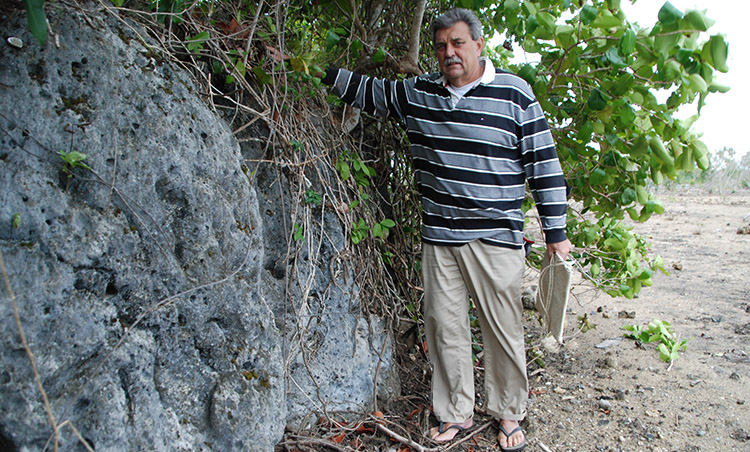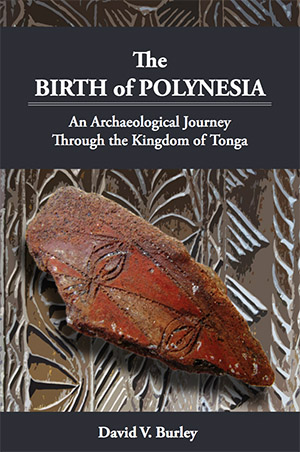
Seventeen hundred years before the dawn of the Viking Age in Europe, the first Polynesians crossed the western flank of the Polynesian triangle to settle in Tonga. Thus began the final chapter in the human settlement of the globe. A newly released book, The Birth of Polynesia: An Archaeological Journey Through the Kingdom of Tonga, documents this story.
The author David V. Burley, who is currently visiting Tonga, is a Professor of Archaeology at Simon Fraser University in Burnaby, British Columbia.
The Birth of Polynesia is based on a research program continuing over a 30-year time span. The search for Lapita sites throughout Tonga, the excavations taking place at many of these, and the events influencing and giving life to the different research programs are narrated. In this there is recognition and tribute to the many Tongans who participated as field assistants or who in different ways informed and influenced the study or made it possible.
For interested readers, it is free to download online at https://doi.org/10.21810/archpress.73
Major migration
The story that unfolds from the investigations in Tonga in many places, surprised the researchers.
“As I began the survey in Vava‘u in 2003, I had a preconceived model for a staged settlement of northern Tonga by Lapita peoples, one where a colonising group progressively moved from Ha‘apai to Vava‘u and then onward...,” Burley writes. However, the results of the Vava‘u survey and then excavations at Ofu, Vuna, ‘Otea, and Falevai began framing a different narrative. “The move to Vava‘u from Tongatapu was not staged but simultaneous and coeval with Ha‘apai,” he says.
The migration story began 5,000 years ago in Southeast Asia.
The ancestral origins of the Polynesians, as revealed in language affiliation, lay in the islands of Southeast Asia, most probably Taiwan. By 5000 years ago a major migration had begun. One group settled in the Bismarck Archipelago off north coast New Guinea where they began to make a distinctive type of decorated pottery. This pottery, now known as Lapita, marks a ceramic trail as the migration spread eastward across Oceania eventually reaching Tonga by 900 BC.
The founding of Polynesia occurs with the arrival of the first Lapita canoes in Polynesia. Burley writes that the story begins at Nukuleka at the eastern entrance to the lagoon on Tongatapu. The pottery, the radiocarbon dates and all other archaeological evidence identifies Nukuleka as first land fall.
“It is the birthplace to which all later Polynesians can trace their ancestry.”
Higher sea level on first arrival
The seascape of Tonga on first arrival was different, with sea levels as much as 1.4 m higher. Nukuleka was a small sandy islet, and much of the lagoon shore, including Nuku’alofa, was under water. The first Polynesians expanded quickly around the shoreline as it then existed, moving northward through Ha‘apai, Vava‘u, Niuatoputapu and Samoa. All of this was instantaneous, occurring within the lifespan of but two to three generations.
The archaeological evidence for this history and following events is provided in detail throughout the book. These data give insight into this ancient past, ranging from Lapita pottery and sites to bird extinctions to the earliest economy to artistic expression. The science behind many of the interpretations is similarly explained in straight forward fashion.
The concluding chapter highlights several takeaways for an understanding of Tonga in the past but also in the present. The most important emphasises the continued link of Tongan peoples to their Lapita ancestry so very long ago. On the book cover is an image of a painted Lapita ceramic sherd from Nukuleka with the highly distinctive ngatu pattern, Tokelau Feletoa. The design is still used today. David writes that it is not just ngatu. The continuity is reflected in many other aspects of traditional material culture, from the two-piece Tongan trolling lure to the kele‘a, a trumpet blown to call people to meetings or alert them in times of danger. Even in the realm of entertainment, a shell game documented in the Lapita archaeology at Nukuleka continues to be played in the vlllage today.
“Tongans have a rich and lengthy heritage, one to celebrate and one to be proud of. It is not just the history of Tongans however, it is the initial chapter in the history of Polynesian peoples,” says David.

Hardcover copies of The Birth of Polynesia: An Archaeological Journey Through the Kingdom of Tonga can be purchased through Amazon.
--
Links to articles by David V. Burley et al in Matangi Tonga Online series on pre-history:
- Ha'apai rock art suggests Hawaiian link about 1400-1600AD
- Tongatapu's astonishing burial mounds
- Giant Tongan fruit-gulping pigeon eaten into extinction
- The last Fale 'Otua in Ha'apai
- 'Ata and its archaeology
- The Lapita origins of Tongan ngatu and design
- Scarcity in Paradise
- Early settlement of Ha‘apai brilliantly laid title to islands
- Taupita –Tonga’s earliest known game
- The first Tongans



